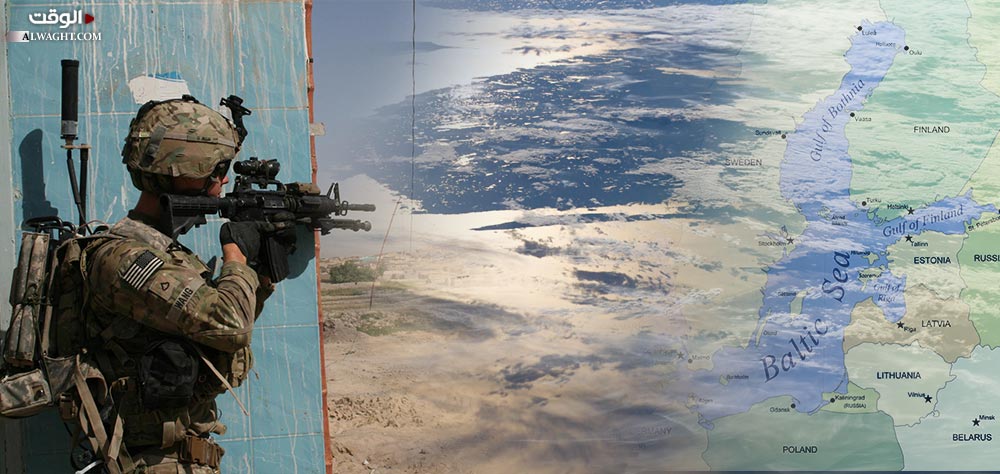Alwaght- The Russian defense ministry on October 12 stated that an entire US army division has been sent to the Baltic states close to the Russian borders, a move clearly violating the Russia-NATO deal.
Massive US military deployment came at the excuse of addressing the concerns of the West after the mid-September Russian-Belarusian Zapad (West)-2017 military drills. The presence has drawn the Russian objection, however, this is not the first time the US is taking such measures.
In 2016 too, Washington sent its troops along with several fighter jets to the Eastern Europe, escalating the tensions with Moscow. The White House argued that its moves go with the terms of the NATO-Russia agreement. Signed between the two sides in 2009, the accord allows the NATO and the US to send forces and equipment through Russia to Afghanistan. The deal needs annual extension to keep standing. However, the Russian leaders accuse the US of abusing the deal and taking provocative steps in the region.
On the Baltic region, there is much to say. The region is the best corridor for the Russian energy exports to Europe. The Baltic states can ensure trade links to other parts of the world. The satellite images of the climatic changes show that the northern coasts will be navigable by 2040 owning to retreat of ice masses over the year. This means that the huge surface and submarine resources will make the region of geopolitical significance as the sea will become available to all. Not to mention that the snow and ice lands offer the best weapons storehouses, including mass depots of missiles.
This picture prefigures potential rise of the Baltic as an important sea. This sea is the only access way of such countries as Poland, Lithuania, Latvia, Estonia, Finland, and Sweden and one of the most important access ways of Russia and Germany to the high seas.
The Baltic region is becoming increasingly crucial for the US. The region offers better spying conditions for Washington, better maneuvering potentials, better capabilities to contain the Russian military rise amid feeling of threats from Moscow against the Baltic states, and better military and economic presence in Northern Europe. More importantly, the region is calling increasing geopolitical attention of Moscow and so automatically creating new pretext for Washington to go there to avoid falling behind. The Russians now have their eyes on the Baltic Sea where they can expand their area of influence. This draws hostile anti-Moscow responses from the US that through military buildup seeks curbing the Russian clout under the cover of protection of the NATO member states in the region. The role the US is intending to play in the Baltic region is in fact part of plans of expansion to the East.
Having in mind that many republics including the present Baltic states are an outcome of the Soviet Union breakup in the early 1990s, Moscow shows extraordinary sensitivity to the American actions like setting up its missile shield system in Poland and Romania and building up its military presence in Eastern Europe. Russia's initial response to the American confrontational measures was deployment of its powerful nuclear-capable Iskandar missiles to Kaliningrad, its closest territory to the Eastern Europe which borders Lithuania. Moscow said the missile dispatch was meant to exhibit the growing Russian military readiness to react to all sorts of threats and provocations.
While the two powers remain involved in unsettled crises in Syria and Ukraine as part of a broader competition, Baltic region appears to be creeping into the list of cases escalating Washington-Moscow tensions. If the US intends to complete the protection belt it is providing to its regional allies close to the Russian borders, there is no doubt that it should anticipate the Russian tough responses. Russia’s joint military exercises, dubbed Zapad-2017, with Belarus that started on September 14 near the Poland and Lithuania borders with participation of 100,000 troops indicated that Moscow has special and serious attention to the region.
The American officials constantly caution the Baltic states' leaders against the potential Russian threats to their national security and even sovereignty. This comes while after the Cold War, the American military presence expanded unprecedentedly, dragging the biggest threat to the Baltic countries by bringing the tensions into the region as Russia opposes such moves on its borders. The European and especially Baltic states' only way to avoid more strain is embarking on more independent policy and refraining from siding with highly escalatory and warlike White House policies.
In peacetime, the US might trumpet support for the regional states, however, the historical experiences bear something else. The Americans in practice only pursue their interests, and give the least worth to their allies when the need arises, a behavior flagging them as untrustworthy partners. On the other side, Russia reserves the right to not be indifferent and respond to the US's threatening measures.



























